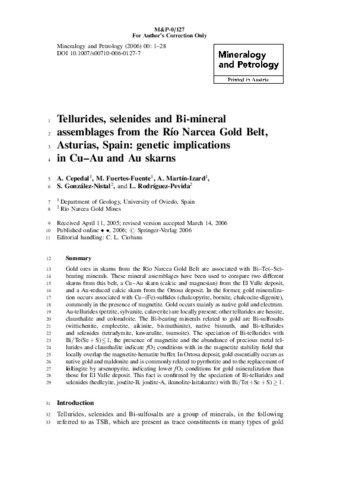Tellurides, selenides and Bi-mineral assemblages from the Rio Narcea Gold Belt, Asturias, Spain: genetic implications in Cu-Au and Au skarns
Palabra(s) clave:
Bismuth chalcogenides
Gold
Tellurides
skarn
El Valle-Boinás
Ortosa gold skarn
Rio Narcea Gold Belt
Fecha de publicación:
Citación:
Descripción física:
Resumen:
Gold ores in skarns from the Rio Narcea Gold Belt are associated with Bi–Te(–Se)- bearing minerals. These mineral assemblages have been used to compare two different skarns from this belt, a Cu–Au skarn (calcic and magnesian) from the El Valle deposit, and a Au-reduced calcic skarn from the Ortosa deposit. In the former, gold mineralization occurs associated with Cu–(Fe)-sulfides (chalcopyrite, bornite, chalcocite-digenite), commonly in the presence of magnetite. Gold occurs mainly as native gold and electrum. Au-tellurides (petzite, sylvanite, calaverite) are locally present; other tellurides are hessite, clausthalite and coloradoite. The Bi-bearing minerals related to gold are Bi-sulfosalts (wittichenite, emplectite, aikinite, bismuthinite), native bismuth, and Bi-tellurides and selenides (tetradymite, kawazulite, tsumoite). The speciation of Bi-tellurides with Bi/Te(Se+S) less or iqual than 1, the presence of magnetite and the abundance of precious metal tellurides and clausthalite indicate fO2 conditions within the magnetite stability field that locally overlap the magnetite-hematite buffer. In Ortosa deposit, gold essentially occurs as native gold and maldonite and is commonly related to pyrrhotite and to the replacement of löllingite by arsenopyrite, indicating lower fO2 conditions for gold mineralization than those for El Valle deposit. This fact is confirmed by the speciation of Bi-tellurides and selenides (hedleyite, joséite-B, joséite-A, ikunolite-laitakarite) with Bi/Te(+Se+S) higher or iqual than 1.
Gold ores in skarns from the Rio Narcea Gold Belt are associated with Bi–Te(–Se)- bearing minerals. These mineral assemblages have been used to compare two different skarns from this belt, a Cu–Au skarn (calcic and magnesian) from the El Valle deposit, and a Au-reduced calcic skarn from the Ortosa deposit. In the former, gold mineralization occurs associated with Cu–(Fe)-sulfides (chalcopyrite, bornite, chalcocite-digenite), commonly in the presence of magnetite. Gold occurs mainly as native gold and electrum. Au-tellurides (petzite, sylvanite, calaverite) are locally present; other tellurides are hessite, clausthalite and coloradoite. The Bi-bearing minerals related to gold are Bi-sulfosalts (wittichenite, emplectite, aikinite, bismuthinite), native bismuth, and Bi-tellurides and selenides (tetradymite, kawazulite, tsumoite). The speciation of Bi-tellurides with Bi/Te(Se+S) less or iqual than 1, the presence of magnetite and the abundance of precious metal tellurides and clausthalite indicate fO2 conditions within the magnetite stability field that locally overlap the magnetite-hematite buffer. In Ortosa deposit, gold essentially occurs as native gold and maldonite and is commonly related to pyrrhotite and to the replacement of löllingite by arsenopyrite, indicating lower fO2 conditions for gold mineralization than those for El Valle deposit. This fact is confirmed by the speciation of Bi-tellurides and selenides (hedleyite, joséite-B, joséite-A, ikunolite-laitakarite) with Bi/Te(+Se+S) higher or iqual than 1.
ISSN:
Colecciones
- Artículos [37544]
- Geología [551]
- Investigaciones y Documentos OpenAIRE [8416]
Ficheros en el ítem





